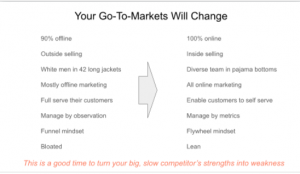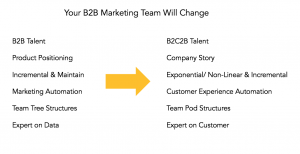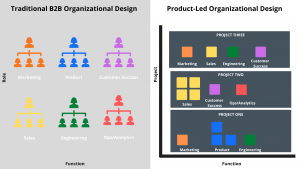In this episode of the GrowthTLDR, we discuss how B2B marketing may change in the future.
We discuss how B2B brands may need to change the talent they hire, how the structure of B2B marketing teams could fundamentally change, and why we should think about customer experience automation vs. marketing automation.
In a recent post by HubSpot CEO and Co-Founder Brian Halligan, he put forward some thoughts on what the new normal will look like.
It's a great post and covers many areas, like your company, your buyer, and your go-to-market.
The go-to-market is of particular interest, as it fits with many of the trends we've heard on the GrowthTLDR podcast:

If you believe companies go-to markets are changing (which I do), then it makes sense that B2B marketing will also change. So, I put together some thoughts on what those changes could be

Here are some of the changes we discussed in the episode:
1. B2B Talent -> B2C2B Talent:
In a recent episode with Blake Bartlett, Partner at OpenView, we talked a lot about how product-led companies have shifted focus from budget owner to end-user.
In days gone by, B2B brands had very niche marketing strategies targeting the small percentage of people who bought their product, not used it. The talent and skills needed to run that playbook differ a lot from B2C.
In the B2C industry, your distribution strategy is 'do or die'; you need to be the brand that scales to the most visits and users in your market.
As B2B go-to markets shift more to end-users, distribution is key to winning in their market. There are a lot more people you can market to. The more end-users who sign up to use your product, the better you can upgrade companies with lots of end-users on the product to your paid plans.
Today, many B2B brands are not thinking about hundreds of new signups per month; they're thinking thousands or hundreds of thousands.
The talent you need to do that is different. You need people who have a mix of B2C and think scale but can still focus on a specific segment of an audience, either role, industry, or a combination of different parameters.
2. Product Positioning -> Company Story
No matter what industry you're in, the number of competitors you have has grown.
Most markets are a red ocean. Every product pitches the same set of features and benefits.
So, why would a consumer pick you?
Having a company story that resonates with your audience has never been of more importance. We talked to Andy Raskin recently about the framework he uses to create a company narrative, and how the first place it's tested is in the sales deck.
As more and more markets turn into a red ocean, a company narrative helps you not just be another list of features to your consumer.
3. Incremental & Maintain -> Exponential & Incremental
Near all brands that go from:
product-market fit -> scale-up -> established company
Go through the same phases.
As they grow, they find a couple of channels/programs that work for growth, and settle in to incrementally trying to get better at those things, and merely maintaining everything else.
Related to the first point, in a world where everyone markets to end-users, distribution becomes more important, and some companies will make investments in their product that help with exponential growth.
A great example of this (everyone also uses it) is Canva, who built a library with millions of templates to help scale growth through organic traffic.
4. Marketing Automation -> Customer Experience Automation
In the traditional B2B world, we generated traffic, converted it into a lead, and then used marketing automation to turn it into an MQL.
In a product-led world, the entire journey of the user matters. The product is at the front and center of that journey.
Your automation should consider how the user signups up to your product, how that signup PQLs, their upgrade experience, their experience when they reach out with a question on the LiveChat, once upgraded, the education they get as a customer.
A companies brand is comprised of three things:
- The inspirational and educational stories you tell
- Your product experience
- Your customer experience
A great product isn't enough if your customer experience is terrible, in a world where people have a lot of choices.
5. Team Tree Structures -> Team Pod Structures
We've talked A LOT about how product-led go-to markets are changing team structures.
The organizational structure, as visualized for most companies, assumes a clear delineation of work among functions. But in product-led organizations, there is an abundance of pods with clear metrics , goals, and accountability.

We talked to Oji Udezue VP of product at Calendly about their approach to pods/squads. It's a fascinating look into the organizational design for product-led companies.
6. Data Expert -> Customer Expert
Ok, so this one won't be controversial, but whoever stays closest to the customer wins.
Without doubt one of the more common trends we've heard from marketers on the GrowthTLDR podcast is just how fantastic their customer research habits have become.
If you're a marketer, an integral part of your role is to become an expert on your customer, using both quantitative and qualitative research.
 iTunes
iTunes Stitcher
Stitcher Spotify
Spotify